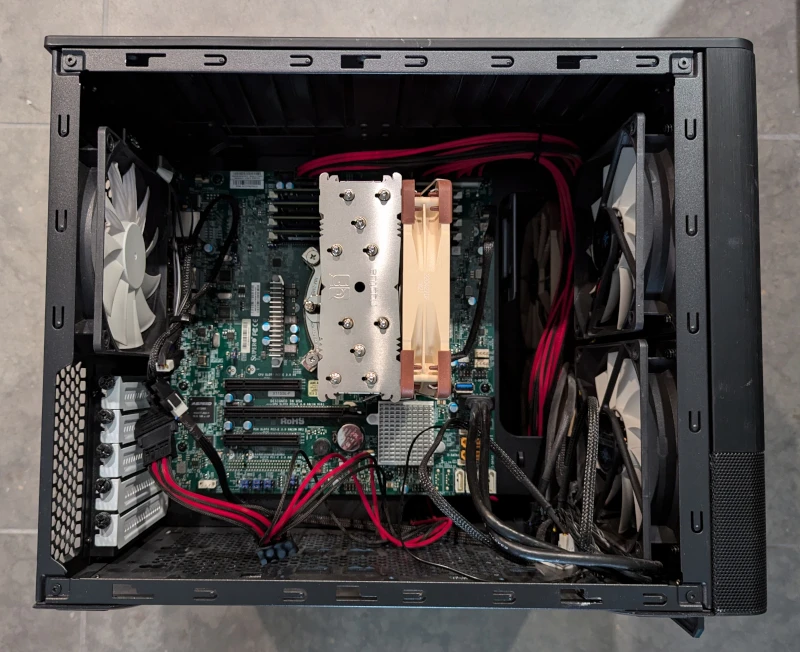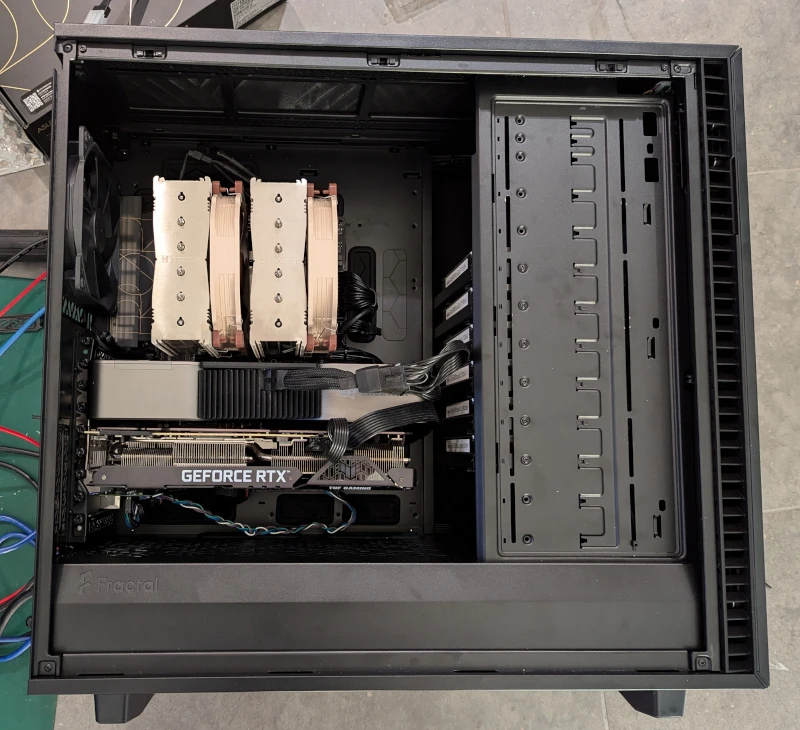State of the home server 2024¶
In 2024 I built a new home server.
Old server¶
This server was great, it served me for 8 years with minor upgrades along the way. The best part was the low idle power, 40-50 Watts with the disks spun up.
I was starting to notice how much slower it was to compile code compared to my workstation, and I was frequently running out of system resources. Even with the maximum 64 GB RAM I ran out of memory when compiling large packages such as chromium.
A bigger problem started when I bought two GPUs to tinker with stable diffusion, Llama, and other emerging tools that utilized GPUs. My PCIe slots were already full with an SFP+ adapter and PCIe to M.2 adapter. Physically the case was too small to fit a large GPU even if I had enough PCIe slots.

CPU: Intel Xeon E3-1230 v5, a 2015 era quad core CPU
Motherboard: Micro ATX Supermicro MBD-X11SSL-F-O, IPMI, 6 SATA ports, not a lot else
RAM: 4× 16 GB Crucial CT16G4WFD8213 DDR4-2133 unbuffered ECC
Case: Fractal Node 804, a 40.3 L case with room for 10× 3.5” drives
NVMe storage: 8 TB Sabrent Rocket 4 Plus
Bulk storage: 6× 20 TB Western Digital Red Pro
New server¶

The new server doesn’t look much bigger, but that’s two GPUs in there!
CPU: AMD Ryzen 9950x, later downgraded to the AMD Ryzen 7950x
Motherboard: Asus ProArt X670E
PSU: Corsair HX1500i
RAM: 4× 32 GB Kingston KSM48E40BD8KI-32HA DDR5-4800 unbuffered ECC
Case: Fractal Define 7 XL
GPUs: 2× second hand 24 GB NVIDIA GeForce RTX 3090
Storage: Re-used from old server
Miscellaneous: PiKVM V4 Mini
The CPU was a hard choice, my first instinct was to go for AMD’s Epyc or Threadripper lines, but these both had problems.
Threadrippers have high idle power, measured at 150 Watts in guru3d’s 7970x review
Threadrippers have no internal graphics, which has always made debugging harder in my experience
Epyc and Threadripper motherboards are expensive, >$1200 CAD
Some $1200 motherboards don’t even have integrated SFP+ or 10 GbE networking ports!
Epyc CPUs have poor performance compared to equivalently priced Ryzen CPUs
I decided to go with a Ryzen desktop CPU because they best fit my desires, a CPU with good performance, low idle power, reasonably priced motherboards, and ECC memory support. In hindsight I would have paid more and purchased an Epyc CPU instead.
I chose the Asus ProArt X670E motherboard because I already owned one for my workstation. The notable features for a server are:
Good Linux support
Minimal extraneous lighting
Advertised ECC support with a qualified vendor list
10 GbE network port
This combination of CPU and motherboard is a choice I would not repeat. The Asus ProArt X670E advertises ECC support, publishing a qualified vendor list with tested ECC memory. I couldn’t find the qualified part KSM48E40BD8KM-32HM because it wasn’t manufactured anymore. Instead I purchased the newer version, KSM48E40BD8KI-32HA. The memory should run at DDR5-4800 with ECC, but at these speeds the system crashed and powered off after a few minutes. I attempted a BIOS update, but after the BIOS update I could only train at DDR5-4400. I suspected the 9950x CPU may be causing problems because it was new at the time, and I swapped the CPU for the 7950x in my workstation. Even with the reduced DDR5-4400 speed and the older 7950x CPU the system would crash after a week of operation. The stable speed seems to be DDR5-4000, which is lower than I anticipated. I don’t know if this is a problem with the CPU, motherboard, RAM, or some combination of the three. In the future I would buy an Epyc part to try and avoid these compatibility issues.
The Corsair HX1500i PSU is a favorite of mine. This line of Corsair PSUs have an internal USB connection which exposes an HID interface with power metrics. Newer Linux kernels have a driver to read voltage, current, and power information directly from these PSUs.
The case is the Fractal Define 7 XL, a massive 77.6 L case with room for two GPUs, and 12× 3.5” HDDs. The case is utilitarian, it’s flat, black, and it has foam lined case panels for acoustic isolation.
The PiKVM is my IPMI replacement. I wanted to manage the server BIOS without connecting a monitor & keyboard. The PiKVM is far better than IPMI in my opinion, uploading ISOs is faster, and the video quality is better with lower latency. I never exposed my IPMI interface to the internet, but the PiKVM makes it easy to modify the nginx configuration to add TLS certificates and other hardening to securely expose it to the internet.
Power draw¶
In an idle state with all 6 drives spun up, the GPU memory populated with an LLM, and a 10 GbE link the AC power draw is ~115 W, as measured by the power supply. I used TLP to turn off desktop components I wasn’t using, Bluetooth, Wi-Fi, and sound.
An IO load on the hard drives, such as a ZFS scrub adds another ~15 W
A GPU load running LLM inference with both GPUs adds ~585 W
A CPU load compiling nix packages adds ~215 W
My IPMI replacement, the PiKVM, adds another 2.5 W.
Services¶
Borg backup: Deduplicating backup tool with compression and encryption.
fail2ban: Ban hosts that cause repeat authentication errors, helps keep my logs readable
Game servers: These rotate frequently depending on what my friends and family are playing, lately Factorio
Grafana: Real time visualizations for Prometheus data
harmonia: Nix binary cache
Home Assistant: Home automation without the cloud
Homepage: A simple dashboard for all other services
Jellyfin: Media player for my families to watch home videos that I converted to digital formats
Mosquitto: MQTT server for my DIY home automation devices
mydav: My DIY webdav server for Joplin notes synchronization
nginx: Reverse proxy to secure services with TLS
openntpd: Local NTP server for my DIY home automation device
PostgreSQL: My choice of database, sane defaults.
Prometheus: Data collection and time series database
Syncthing: File synchronization, primarily used for photo synchronization from my phone
WireGuard: Fast VPN to access services from outside my network
New in 2024¶
Forgejo runner: CI runner for Forgejo
Forgejo: A web interface for git repositories
Keycloak: Single sign on provider
Tang: Service to automatically decrypt LUKS disks on other systems
llama.cpp: LLM inference engine with lightweight WebUI
minio: Object storage with S3 compatible API, handy for sharing large files with expiring URLs
oauth2-proxy: Add single-sign-on to services that don’t natively support it
oidc_pages: Serves various static HTML websites for myself and my family
Single sign-on¶
The biggest change this year is adding SSO to majority of my self-hosted services. I used Keycloak as my SSO provider, because it was well supported in NixOS. Obligator has a great comparison table if you’re looking at the available options for SSO.
Most applications integrate with Keycloak through the OpenID Connect (OIDC) standard, a superset of OAuth2.
To better understand OIDC I built oidc_pages, a service to secure static HTML pages with OIDC for authentication and authorization (permissions). This project was a great learning experience because I now understand why authorization/permissions management is difficult with OIDC, it’s not part of the specification. I had to write Keycloak-specific code to authorize specific users for specific pages.
Some services I run such as Grafana, Forgejo, and minio support OIDC natively, but most such as llama.cpp don’t have OIDC support. For applications without native support I used oauth2-proxy.
I still have two major outliers without OIDC, Home Assistant and Jellyfin. It’s possible to secure these with OIDC, but then the mobile applications don’t work. There are community efforts to add OIDC to these, but take time before they make it into an official release.
Forgejo¶
Forgejo is a git WebUI, it’s a fork of Gitea, which is a fork of Gogs.
Previously I was using bare git repositories on my server over SSH. I decided to run Forgejo for the CI capabilities to build my internal homelab documentation.
NixOS uses their own CI tool, [hydra], but it doesn’t have native OIDC.
minio¶
minio is a self-hosted object storage service with an S3 API. minio is capable of a lot, but I use it as a simple way to share large files.
It’s a two step process to generate a temporary download link:
Upload file to bucket
mc cp photos_to_share.zip myminio/share/Share uploaded file:
mc share download myminio/share/photos_to_share.zip
llama.cpp¶
With two 24 GB NVIDIA 3090’s I can run a 70B model with 4-bit quantization using llama.cpp, an LLM inference engine. The primary reason for self-hosting is tinkering, when I want to learn more about something I work on a related project.
llama.cpp comes with a lightweight WebUI which I find sufficient for my needs.
Currently I’m running Meta’s Llama-3.3-70B-Instruct, a general-purpose conversational model that’s competitive with paid solutions from other companies.
I often get asked if I am saving money by self-hosting LLMs. The quick answer is no. I paid $2000 CAD for two used 3090’s, and at the time of writing LLM subscriptions are ~$33 CAD. Ignoring the cost of electricity the 3090’s need to operate for at least 5 years before I break even.
The 1B and 3B Llama 3.2 models also run great on my phone. They have been useful a couple times for answering questions when I don’t have internet access.
Data storage¶
On my home server I use ZFS in raidz3, giving me 51 TiB of usable storage from the 120 TB of raw storage. I don’t need 3 disks of hardware redundancy in a 6 disk array, but I am planning to add more drives as necessary with the new raidz expansion feature. With raidz expansion I can add more disks, but I can’t change the RAID configuration. RAIDZ3 doesn’t make sense with 6 disks, but it does make sense if I end up with 12 disks by the time this server reaches its end of life.
Backups¶
My backup server lives with a family member, in exchange they can backup their data to the server.
The backup server is an old desktop with my old disks, 7× 10 TB WD Red HDDs. I have the disks in an ext4 SnapRAID array with a single parity disk. SnapRAID is snapshot based, and if any disk in the array dies the data on the remaining disks is recoverable. I keep track of what data lives on each disk, if I have a double disk failure I can restore the missing data from the primary server.
I used ext4 and SnapRAID on the backup server because I have experienced ZFS data corruption bugs. Using a different filesystem for the backup server lets me recover from future ZFS data corruption bugs.
To move data between my home server and the backup I use Borg backup. Borg is the one-stop-shop for backups, with support for snapshots, compression, end-to-end encryption, and deduplication.
Looking forward¶
There are a lot of things I want to self-host in 2025!
Immich, a self-hosted photo and video solution. I want to be able to access my photos from a WebUI. Immich seems like a great solution because it can use my existing EXIF data for organization, and it has OIDC for single sign on.
ArchiveBox, a self-hosted internet archiving service. I archive pages on archive.org all the time for future reference, it’s useful when I open an old bookmark and the page no longer loads. The internet archive is often slow, and it’s always under legal pressure. My hope is that a self-hosted solution is faster.
SearXNG, a self-hosted metasearch engine. Lately my search results have been overrun by SEO spam, even for many technical topics. I am not sure if SearXNG can help with filtering SEO spam, but I want to explore alternative search engines. While not self-hosted kagi is another option in the search space I hear a lot about.